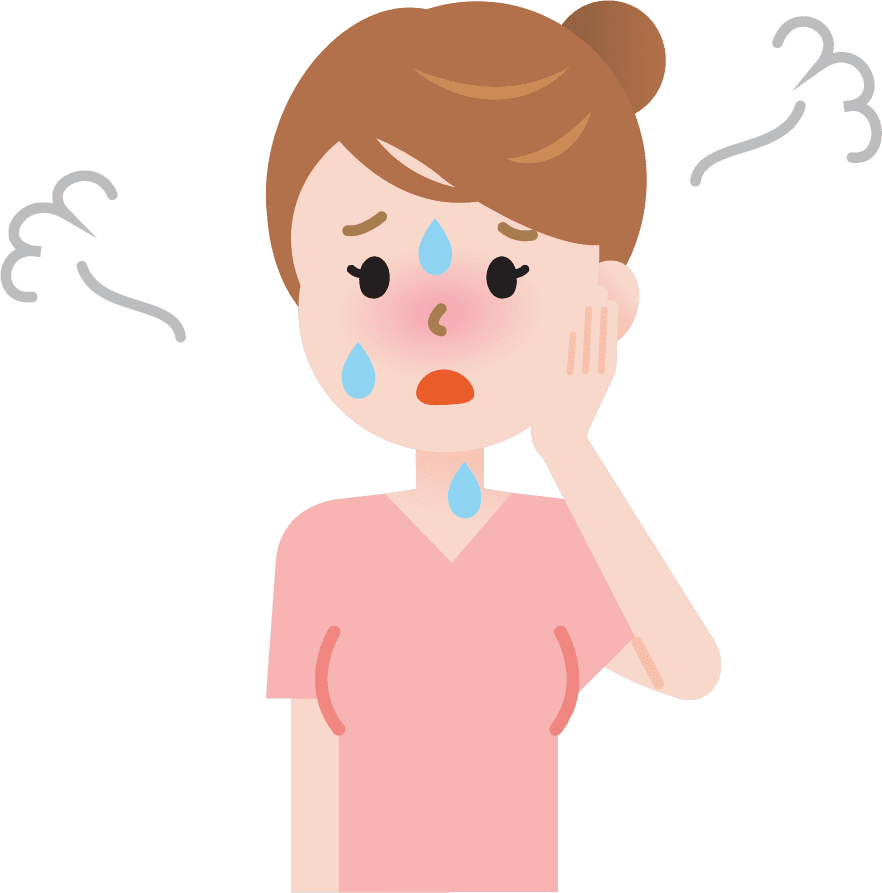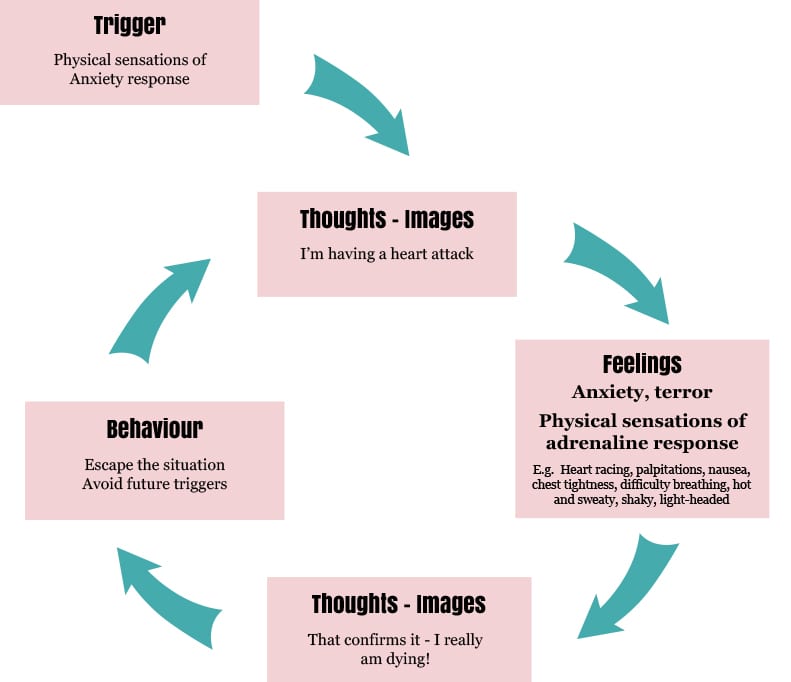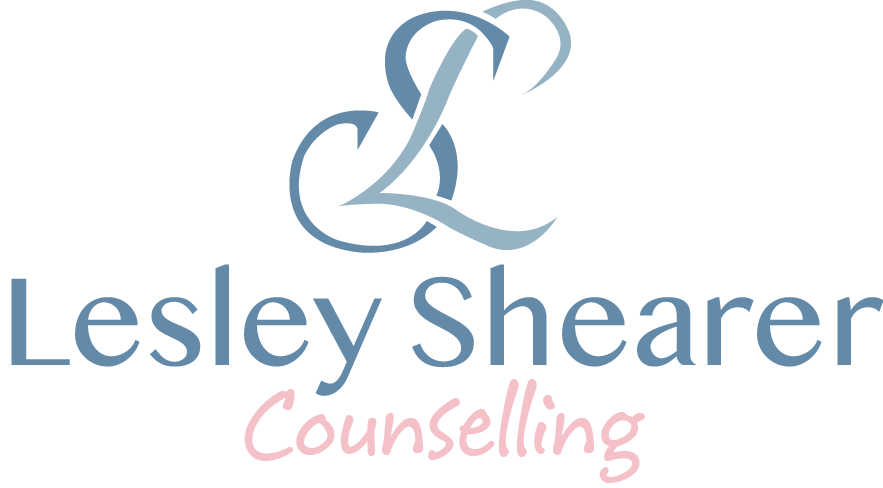
Panic Attacks

Panic Disorder is an anxiety disorder where individuals experience repeated panic attacks. The normal physical sensations of anxiety are experienced as “dangerous” to the individual who then believes the symptoms mean they are going to die (heart attack, will suffocate etc).
Naturally, no-one wants these panic attacks, so we may start to avoid situations where they might occur, and “fear the fear” – we are scared about experiencing the panic attack. Avoidance can lead to agoraphobia (from the Latin for fear of open spaces), where we avoid certain places because of the fear of a panic attack and of not being able to escape, which eventually may keep us from going out at all.

Self Help for Panic Disorder
Cognitive Behaviour Therapy focuses on learning to challenge the unhelpful thoughts and beliefs, and gradually making changes in our behaviour so that we learn that the feared consequences do not happen, and that it is anxiety that makes us feel the way we do.
In order to break the vicious cycle of repeated panic attacks and/or agoraphobia, we need to change the way we think, and change what we do. Firstly, we can learn about how any anxiety affects our body. This is the body’s normal response to danger (or believing we’re in danger):
Read Alarming Adrenaline
The main problem with panic disorder is that when those adrenaline feelings really kick in, they feel like we are really suddenly seriously ill. It can feel like we are choking, suffocating, having a heart attack. It really feels like we could be dying, right now! Terrifying.
In fact, these physical feelings of adrenaline are normal – it is simply the body’s alarm system being activated in order to help us escape from a dangerous situation. So it feels dangerous, even if it really is not.
We add meaning to the thoughts and feelings – we believe the thoughts, and we think the feelings mean we could be dying.
The feelings will pass. If we could just notice the thoughts and feelings, and not react to them by believing them to be dangerous in themselves, if we could breathe deeply and focus on our breathing and allow the thoughts and feelings to come, and go, then the adrenaline will calm down within a few minutes.
The most effective technique for stopping a panic attack – even before it starts – is to:
- Use STOPP skill.
- Focus on deep and slow belly Breathing.
- Let other thoughts and feelings come and go as they will.
- Just notice the thoughts and feelings, then think about your breathing again.
- Once the worst of the feelings have passed, then choose what to do now – where to focus. Either carry on what you were doing, or do something else – with your full attention.
THINKING DIFFERENTLY: Challenging Thoughts
If we can change the way we think about a situation or about the normal anxiety feelings, then we will not feel so panicky. We can learn to challenge those anxiety-provoking thoughts. Thoughts are not statements of fact. Don’t believe everything you think!
- Learn more About Automatic Thoughts
- Learn Fact or Opinion skill
- Learn about The Mind Bully
Thoughts are just thoughts. We look at life, and situations through distorted lenses. Just because we think we are going to die, or have another panic attack, doesn’t mean that is how it really is! We are looking at the physical sensations of adrenaline or going out or to certain places or situations, through those very distorted lenses.
- Read: Different Perspectives
Learn to challenge the unhelpful and distorted thinking:
- Use the Vicious Cycle and Alternatives to map out your own thoughts, feeling and behaviours, and generate some healthier alternative thoughts and behaviours.
- Use this Panic Thought Record Sheet to help learn to challenge the thoughts.
- Practise STOPP skill.
- Learn to use Positive Coping Statements.
THINKING DIFFERENTLY: Re-Focus
When we think about being in a situation or when we start to feel anxious, our focus of attention gets totally caught up in our own thoughts and feelings. The physical feelings of anxiety just makes it worse, as we start to believe we could be dying. It can be a horrible experience which leaves us feeling battered and exhausted – we just want to escape that situation to stop the feelings – and avoid repeating them!
It is very helpful to learn how to change our focus of attention and take more control over how we react to thoughts. We can learn to just notice the thoughts and physical sensations of anxiety, acknowledge them, then let them pass. Notice the Mind Bully and let it go – turn your focus of attention to something else. First of all, you might learn to focus on your breathing.
- Practise Mindful Breathing
Then you might learn and practise Mindfulness skills and Mindful Activity. It is important to practice these skills frequently, every day, so that when you NEED them, you’ll be able to use them effectively.
NOW
Notice: Where my attention is.
Observe: What I’m doing. Think: “I am walking”, “I am sitting”, “I am breathing”, then notice those sensations in your body
Wise Mind: What now? How shall I continue? Doing or Being?

MINDFULNESS FOR BUSY PEOPLE
- Choose an activity to do mindfully throughout the day, for one, two or five minutes. For example: Drink a cup of tea. Walk. Wash the dishes.
- Whatever you are doing, be in that moment, right now. See, hear, smell, touch, feel, breathe.
- Simply notice whenever other thoughts and sensations come to mind, then re-focus on your chosen mindful activity.
- Be patient and compassionate with yourself.
-
Describe the experience rather than using judgemental words like good or bad, pleasant or unpleasant.
- It is as it is.
Everything Flows. Nothing is fixed. Heraclitus
Doing Differently
Our usual strategy for dealing with social anxiety, is to avoid social situations. However, that just serves to keep the anxiety and panic going because we never find out that things will be okay.
Use the Avoidance worksheet to gradually face your fears
Slowly, we can change what we do. Use the Avoidance worksheet to identify what you don’t do or where you don’t go, then start by gradually exposing yourself to the least feared situation in the list, using healthy coping strategies in those situations.
It’s important that you see the situations through – stick with the anxiety – it will pass.
Use STOPP skill to incorporate all these strategies
STOP – just pause for a moment.
Take a breath – one slow deep breath.
Observe – there’s the mind bully again. My body and mind is reacting to the thoughts and anxiety feelings.
Pull back – this is just the anxiety talking. Don’t believe everything you think! Let’s stick with the facts – these thoughts are just opinions (ask yourself if this is fact or opinion). These feelings are normal – it’s just the body’s alarm system doing its job, when it doesn’t need to. These feelings will pass.
Practise / Proceed – What can I do right now? I can use these strategies:
- Mindful Breathing
- Panic Thought Record Sheet
- Avoidance Worksheet
- Positive Coping Statements
- NOW: Mindfulness for Busy People
Where can I put my focus of attention right now? (Mindfulness and mindful activity). What else can I do that would help me tolerate these thoughts and feelings without reacting to them?
Complete your own STOPP Worksheet

Use STOPP skill to incorporate all these strategies
STOP – just pause for a moment.
Take a breath – one slow deep breath.
Observe – there’s the mind bully again. My body and mind is reacting to the thoughts and anxiety feelings.
Pull back – this is just the anxiety talking. Don’t believe everything you think! Let’s stick with the facts – these thoughts are just opinions (ask yourself if this is fact or opinion). These feelings are normal – it’s just the body’s alarm system doing its job, when it doesn’t need to. These feelings will pass.
Practise / Proceed – What can I do right now? I can use these strategies:
- Mindful Breathing
- Panic Thought Record Sheet
- Avoidance Worksheet
- Positive Coping Statements
- NOW: Mindfulness for Busy People
Where can I put my focus of attention right now? (Mindfulness and mindful activity). What else can I do that would help me tolerate these thoughts and feelings without reacting to them?
Complete your own STOPP Worksheet



